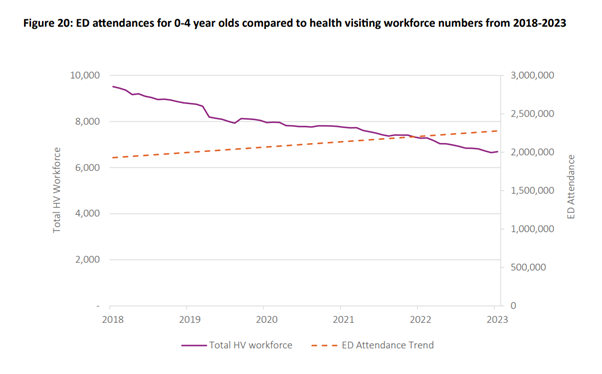More babies attending A&E as health visitor numbers fall

A decline in health visitors in England has coincided with an increase in families attending A&E with concerns about their babies, new research reveals.
The Institute of Health Visiting (iHV) said the findings showed that cuts to health visiting were a “false economy” and called for action to boost numbers of these nurses.
“Cuts to health visiting services over the last eight years have been a false economy”
Alison Morton
According to the new iHV report, released alongside a new short film, babies under the age of one have the highest rate of A&E or emergency department (ED) attendance compared to any other age group in England.
The rate of 0-4-year-olds attending A&E has increased by 42% in the last 10 years: from 1.8 million in 2012-13 to nearly 2.6 million in 2022-23.
The iHV said its research suggested that a large proportion of these attendances would have been avoidable if there was better support in the community, such as from health visitors.
In 2022-23, 183,958 child attendances to A&E resulted in nothing wrong being found with the patient, a rise from 122,711 in 2019-20.
‘No abnormality detected’ was the second most common presenting condition for 0-4 attendances to A&E in 2023, behind only ‘upper respiratory infection’, according to NHS England data.
In one area – North West London – an analysis of 21,000 infant attendances to A&E, for the period of April to December 2022, found that 59% required no treatment.
The iHV team calculated that, in this area alone, these unnecessary visits would cost the NHS £1.8m a year, which it argued would be “better spent in strengthening community and primary care services”.
In its report, titled Understanding the rise in 0-4-year-old ED attendances and changing health visiting practice, the iHV presented a graph showing how the increase in child attendances to A&E had aligned with a decline in health visitor numbers.

The iHV said data from NHS and independent providers in England suggested that, as of this year, there were 6,441 full-time equivalent health visitors in the country – a decline of more than 40% since 2015.
In its report, it said: “There are numerous variables that impact on parents’ decisions to attend the ED when their baby or child is unwell, and we are unable to attribute direct causation of rising ED attendances to any single factor.
“However, the increase in ED attendances in babies and young children in recent years has coincided with the significant reduction in health visitor support, falling health visitor workforce numbers, and the closure of easily accessible health visitor drop-in baby and child health clinics in the heart of communities over the same time period.”
As part of its report, the iHV surveyed health visitors and, when asked what parents needed to help them better deal with minor illness in their children, the most common answer given (76%) was ‘more health visitors’.
The iHV said many respondents highlighted the shortage of health visitors as a “contributory factor to the increase in ED attendances”.
One health visitor said: “I believe the massive cut back on universal provision is having a negative impact on ED attendances.”
Among the iHV’s recommendations in its report were for investment to recruit 5,000 more health visitors in England, and for the government to make sure it included babies and young people in its plans for addressing pressures in urgent and emergency care services.
It also said that a “national model of effective practice is needed to reduce ED attendances in children 0-4 years with relatively minor and self-limiting conditions”.
“This model should support local integrated care systems to improve prevention and early intervention through health visiting services and maximise digital solutions,” added the report.

Alison Morton
Alison Morton, iHV chief executive, stressed that the new report was “not about blaming parents” but rather it was about highlighting where the solutions lie.
She added: “Cuts to health visiting services over the last eight years have been a false economy with fewer health visitors available to support families through prevention and early intervention in the community.
“The knock-on consequences have been felt across the health and care system, including A&E departments.
“To tackle the problem, we need to provide better support for families in the heart of communities and this includes rebuilding the health visiting service in England.”






